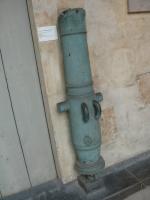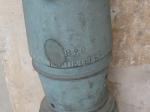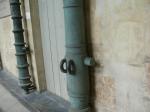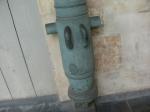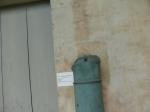122mm 1828 Canon Edinorog dit Licorne Paris
English Translation
Historique Voir ICI
History Click HERE
L'artillerie Russe des Guerres Napoleonniennes
En cette fin du XVIII° siécle les officiers surtout subalternes de l'artillerie russe ne sont pas au niveau des offciers des autres puissances européennes Ils ne recoivent pas d'enseignement et ils sont pas recompensés A eux les servitudes aux officiers supérieurs issus de la noblesse de cour les honneurs . Il est courant que les officiers supérieurs ne viennent que pour faire tirer "leur baterie" et ensuite ils retournent à la cour
aussi le Tsar Paul décide de reformer tout cela
 |
 |
| Paul I° (1754 1801 ) |
|
Il faut dire que l'artillerie russe à la fin du règne de Catherine était dans un état lamenable avec des pièces trop lourdes , et des artilleurs pas formés. Il n'y avait aucune normalisation dans les calibres nni les affuts
En 1800 , l'artillerie russe est bonne derniere derrière l'artillerie française , britannique et autrichienne et même derrière les Prussiens , qui avaient créer leur école d'artillerie a été créé en 1791.La première école d’artillerie française ouvrit ses portes en 1679 de plus les francais avaient développé dans les années 1760 et 1770 un d'enseignement de coopération intermarmes pour les officiers d'artillerie et sous-officiers .Les Autrichiens avaient d'ailleurs copié les écoles d'artillerie françaises avec de bon résultats dans les années 1780 et au-delà )
En temps de paix , les artilleurs sont organisés comme fantassins , et ne recoivent qu'occasionnellement des cours d'artillerie . ils ne forment des régiments que lors des campagnes aussi ils ne savent pas manoeuvrer avec l'infanterie et la cavalerie. De plus les chevaux d'artillerie ne sont achetés qu' au début de la guerre
Le Tsar Paul réforme tout cela en creant un eécole qui donne un enseignement d'artillerie spécialisée
Le train d'artillerie a été militarisé en 1803 (trois ans après les français)
Toutefois, « l'enseignement militaire entre 1800-1808 est pauvre et inadapté
Les enseignements fournis par les campagnes de 1805-1807 , prouvent qu'il n' a aucune cooperation intrarme contrairement aux français qui appliquent cette tactique depuis 1765.
Les officiers d'artillerie comme Sievers et Yermelov essayent de changer les choses , mais ils se heurtent à une hiérarchie qui bloque toute reforme
Après la campagne 1806-1807 , le Major Général Sievers , commandant d'une brigade d' artillerie , écrit un rapport sur la tactique et de l'équipement d'artillerie . Il a écrit que si le matériel de l'artillerie française n'était pas melileur que le Russe ,la différence se fait au niveau du commandement
La tactiques russe prevoit de neutraliser les batteries adverses ( faire taire les batteries) ce qui entrainement une grosse consomation d'obus et une perte de temps qui ne profite pas à la maneouvre
De plus le positionnement des batteries est primordial Si les francais les positonnent correctement à contre pente pour les obusiers ou à défilement pour les canons normaux , les russes font tout le contraire et subissent des pertes enormes
A compter de 1808 les choses changent les Artilleurs recoivent un meilleur enseignement et des examens sont organisés pour ceux qui veulent devenir officiers
La garde Impériale recoit elle une formation sérieuse dès 1808
les cours et livres commencent à apparaître à partir 1808-1810 , bien que le manuel Sievers ne pas publié avant 1811
Le Général d'Artillerie Kutusaiv publie ses Règles générales pour l'artillerie en 1812.
en 1813-1814 cela commence a aller mieux
Mais il reste encore beaucoup de chemin car les russes ne possèdent pas des officiers comme Senarmont et Drouot
 |
Les canons.
L''artillerie a été divisée en artillerie Navale et terrestre elle meme subdiviée en
Artillerire de Place avec canons lourds en poste fixe et coulé en fonte
Artillerie de Siege avec canons en cuivre assez mobile
Artillerie de campagne avec canon leger en cuivre mobile
L'artillerie de campagne est elle même divisée
Artillerie lourde placées en batterie (redoutes)
Artillerie légère utilisée sur le chmap de bataille
Artillerie à Cheval des mobile avec attelage avec 2 chevaux
Par contre l'artillerie de montagne,n'apparaitra que plus tard
Les Canons Edinorog ou Licorne
 |
 |
| Pièce 10 livres Edinorog |
Piece de 10 |
 |
 |
Le canon de dype Enidorgo ou Licorne fut indruduit en 1757 suite aux travaux de M.V.Martynovym M.G.Danilovym qui travaillaient sous la direction du général comte Chouvalov, Ce type de canoin devait dans l esprit des concepteurs remplacer les obusiers et canons. Plus tard suite à divers problèmes, ils furent reclassés comme obusiers. Ils tirent leurs nom de l'animal mythique présent sur le blason de Chouvalov.
Russion Artillerie during Napoleonic Wars
 |
At the begnining artillery officers artillery officers of inferior rank have not the same title to estimation as in the toher European services, for their education is not formed with the same care, and their service does not receive the same encouragement. To them is the toil and responsibility, but the honor is by no means assured them. Some favorite officer, completely ignorant of the science and practice of the artillery, is frequently in the day of action appointed for the day to the command of their batteries, and the credit is in the dispatches given to him for a service which depended on long previous systematic arrangements and laborious attention, with which he never was acquainted: an injustice mortifying to the corps, injurious to the individual artillery officer, and gravely detrimental to the general interests.
Tsar Paul started the reforms of the Russian artillery, the Russian artillery at the end of Catherine's reign 'the Russian artillery pieces were too heavy, and the artillerymen were not well-trained. There was no strict standardization of barrels and carriages. During peacetime, artillerymen were organized as infantrymen, and were trained to fire from various artillery pieces, but only in the beginning of a campaign were they given the pieces with which they served in the campaign. The artillerymen were not trained to maneuver their pieces, because most artillery horses were purchased at the start of a war
Tsar Paul reformed much of this, especially in organization and training, but at the same time he reorganized the Artillery and Engineer Cadet Corps, renaming it the Second Cadet Corps in which no specialized artillery education was given. The curriculum mirrored that of the Second Cadet Corps (formerly the Land Cadet Corps).
This was circa 1800 and this placed the Russian artillery behind the French, British, and Austrian artillery in the education of its officers, and even behind the Prussians, as their artillery school was established in 1791.
The artillery train was militarized in 1803 (three years after the French) and Wilson remarked on the efficiency of the drivers and the excellence of the horse teams. However, 'the military educational establishments in 1800-1808 did not provide any special artillery training
Artillery tactics were obsolete in the campaigns of 1805-1807, and there was no training in infantry/artillery and cavalry/artillery cooperation as there was in the French service since 1765. Russian command and control of their artillery at higher levels (corps and army) was very poor, and this continued throughout the period. Artillery officers such as Sievers and Yermelov tried to change things, but it was an uphill fight to get what they thought was a better way of employing their artillery.
After the 1806-07 campaign, Major General Sievers, commander of an artillery brigade, wrote a report on artillery tactics and equipment. He wrote that French artillery equipment was not better than the Russians, but French commanders used their artillery more skillfully; they chose better positions for artillery batteries, and the actions of their whole army helped their artillery to be more effective. This was because they usually outflanked the Russian Army, so taht their artillery fire was concentrated at the Russian lines, and the Russian reserves were under a crossfire (though, at the same time Sievers noticed that the French liked to fire at a long range, elevated the barrels of their pieces too high in order to do that, and so their fire was not very effective). Comparing the ways of selecting artillery positions, Sievers wrote that the Russians usually placed their artillery on every hill in their position, so that the enemy could count almost all Russian guns. In contrast, the French placed their batteries of howitzers in depressions or behind hillocks, so that their artillery pieces could not be observed by the Russians. He also wrote that Russian artillerymen often fired at enemy batteries, and that senior commanders were partly responsible for that, because some of them liked to give orders to 'silence the enemy battery.' In order to perform this counterbattery fire, the Russian artillery expended too much ammunition and time.'Enlisted artillerymen were trained in their companies and NCOs who wanted to become officers had to pass an exam given by the Artillery Committee. Those who were coming out of the Cadet Corps and wanted to go into the artillery also had to take an exam. The only formal education for artillery officers after 1808 was a class in the Guard artillery.After 1808 Russian artillery doctrine began to change. Articles and manuals started to appear from 1808-1810, although Sievers' manual didn't get published until 1811. Much of what was published was copied from Guibert and du Teil, and French practices were adopted, such as how the ammunition resupply was handled in combat and how many caissons per gun were on the gun line. Artillery General Kutusaiv published his General Rules for Artillery in 1812.Russian artillery organization continued to improve and was at its best in 1813-1814. Command and control at corps and army improved, but it was still in the embryonic stage compared to what the French were capable of doing. The Russians did nothing compared to what French artillery officers such as Senarmont and Drouot achieved on the battlefield with aggressively handled artillery. In the French army, that new doctrine had been developed in the 1760s and 1770s and their education establishment for artillery officers and NCOs was excellent (the Austrians had copied the French artillery schools for their own efforts which had very positive results in the 1750s and beyond). The Russians started late. Their existing education system for artillery officers was abolished around 1800 with detrimental effects to the arm. They never really caught up.
The Guns
 |
'Artillery was divided into Naval artillery and ground and Ground was divides in
Fortress Artillery with heavy guns in stationary and cast iron
Heavy artillery with guns in copper mobile enough
Filed Artillery with lightweight mobile and gun in copper
Field artillery is itself divided
Heavy Artillery placed in battery (redoubts)
Light artillery used in the battlefieldH
orse Artillery mobile hitch with 2 horses
As against the mountain artillery, do appear later
Guns Enidorgo or Unicorn
The gun-type Enidorgo or Unicorn was introduced in 1757 following works of MVMartynovym MGDanilovym working under the direction of General Count Shuvalov, Such canoin was in the minds of designers replace howitzers and cannons. Later after some problems, they were reclassified as howitzer The name derive from the mythical animal present on the crest of Shuvalov.






